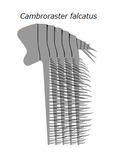| Cambroraster Temporal range: Mid Cambrian: Chengjiang–Burgess shale PreꞒ Ꞓ O S D C P T J K Pg N | |
|---|---|

| |
| Fossil of a Cambroraster head sclerite (ROMIP 65079) | |
| Video animation | |
| Scientific classification | |
| Domain: | Eukaryota |
| Kingdom: | Animalia |
| Phylum: | Arthropoda |
| Order: | †Radiodonta |
| Family: | †Hurdiidae |
| Genus: | †Cambroraster Moysiuk & Caron, 2019 |
| Type species | |
| Cambroraster falcatus Moysiuk & Caron, 2019 | |
| Species | |
| |

Cambroraster is an extinct monotypic genus of hurdiid radiodont, dating to the middle Cambrian, and represented by the single formally described species Cambroraster falcatus. Hundreds of specimens were found in the Burgess Shale, and described in 2019. A large animal (for its era) at up to 30 centimetres (12 in) (but not as long as Titanokorys at 50 centimetres (20 in)), it is characterized by a significantly enlarged horseshoe-shaped dorsal carapace (H-element), and presumably fed by sifting through the sediment with its well-developed tooth plates (oral cone) and short frontal appendages with hooked spines. Nicknamed the "spaceship" fossil when first found, for the way its dorsal carapace resembles the fictional Millennium Falcon, the specific epithet falcatus in its scientific name is a nod to that resemblance.
A second species of Cambroraster is known from the Chengjiang Biota of South China, making it the first uncontroversial hurdiid from the Cambrian of China. This species is known only from a juvenile dorsal carapace, so it was not given a specific name.
Although originally suggested to have used its frontal appendages to sift sediment for prey, a later study by different authors suggested that it may have been a filter feeder instead.
See also
References
- ^ Moysiuk, J.; Caron, J.-B. (31 July 2019). "A new hurdiid radiodont from the Burgess Shale evinces the exploitation of Cambrian infaunal food sources". Proceedings of the Royal Society B: Biological Sciences. 286 (1908): 20191079. doi:10.1098/rspb.2019.1079. PMC 6710600. PMID 31362637.
- Wu, Katherine J. (30 July 2019). "Meet Cambroraster falcatus, the sediment-sifting 'Roomba' of the Cambrian". Nova. Retrieved 31 July 2019.
- "A voracious Cambrian predator, Cambroraster, is a new species from the Burgess Shale". Phys.org. Royal Ontario Museum. 30 July 2019. Retrieved 4 August 2019.
- "Scientists name new fossil species after Millennium Falcon from Star Wars". Ars Technica. 3 August 2019. Retrieved 4 August 2019.
- Liu, Yu; Lerosey-Aubril, Rudy; Audo, Denis; Zhai, Dayou; Mai, Huijuan; Ortega-Hernández, Javier (2020). "Occurrence of the eudemersal radiodont Cambroraster in the early Cambrian Chengjiang Lagerstätte and the diversity of hurdiid ecomorphotypes". Geological Magazine. 157 (7): 1200–1206. Bibcode:2020GeoM..157.1200L. doi:10.1017/S0016756820000187. ISSN 0016-7568.
- De Vivo, Giacinto; Lautenschlager, Stephan; Vinther, Jakob (2021-07-28). "Three-dimensional modelling, disparity and ecology of the first Cambrian apex predators". Proceedings of the Royal Society B: Biological Sciences. 288 (1955): 20211176. doi:10.1098/rspb.2021.1176. ISSN 0962-8452. PMC 8292756. PMID 34284622.
| Radiodonta | ||||||||||||||||||
|---|---|---|---|---|---|---|---|---|---|---|---|---|---|---|---|---|---|---|
| ||||||||||||||||||
| ||||||||||||||||||
| Taxon identifiers | |
|---|---|
| Cambroraster | |




